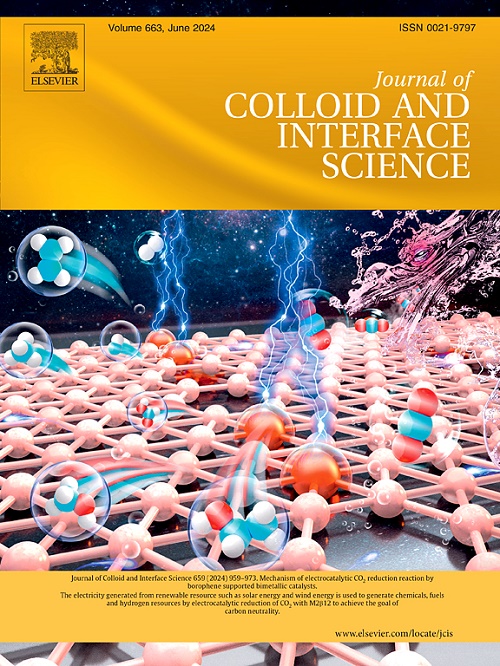粒度对聚乙烯吡咯烷酮(PVP)控制合成制备的(CoFeNiMnCr)3O4 的结构和氧进化反应催化剂的影响。
IF 9.4
1区 化学
Q1 CHEMISTRY, PHYSICAL
引用次数: 0
摘要
本研究采用 PVP 辅助溶胶-凝胶法合成了高熵尖晶石氧化物 (CoNiMnFeCr)3O4,这是首次报道采用这种方法生产高熵氧化物。这种方法为通过煅烧过程中的精确温度控制实现形态定制提供了新的见解。样品分别在 800、900 和 1000 °C 煅烧,并进行了结构、光学和电化学表征,以评估合成条件对氧进化反应(OER)性能的影响。X 射线衍射 (XRD) 证实形成了面心立方对称的单相尖晶石结构。紫外可见光谱显示了与煅烧温度相关的带隙偏移,表明电子结构发生了微妙变化,从而影响了催化行为。S-HEO 800 样品的催化活性最高,在 10 mA cm-2 的条件下,过电位达到 316 mV。电化学测试表明,电极具有出色的短期耐久性,在 10 mA cm-2 的条件下可保持稳定性能 24 小时。场发射枪扫描电子显微镜(FEGSEM)分析表明,颗粒尺寸随煅烧温度的升高而增大,从 96 nm(S-HEO 800)到 475 nm(S-HEO 1000)不等。X 射线光电子能谱(XPS)显示,S-HEO 800 表面的 Cr6+、Cr4+ 和 Ni3+ 离子浓度更高,这与其卓越的 OER 性能相关。此外,拉曼光谱和傅立叶变换红外光谱证实了尖晶石相的形成,并提供了对金属氧键的深入了解。电化学阻抗光谱(EIS)结果表明,S-HEO 800 的电荷转移电阻(Rct)最低,进一步证明了其催化性能的增强。这些发现证明了 PVP 辅助溶胶-凝胶法生产具有可调形貌的定制化高熵氧化物的潜力,使它们成为能源转换应用,尤其是水电解应用的理想候选材料。本文章由计算机程序翻译,如有差异,请以英文原文为准。

The effect of particle size on structural and catalysts for oxygen evolution reaction of (CoFeNiMnCr)3O4 prepared by controlled synthesis with polyvinylpyrrolidone (PVP)
In this study, high-entropy spinel oxides (CoNiMnFeCr)3O4 were synthesized using a PVP-assisted sol–gel method, marking the first report of this approach for producing high-entropy oxides. This method provides new insights into morphology customization through precise temperature control during calcination. Samples were calcined at 800, 900, and 1000 °C, and structural, optical, and electrochemical characterizations were performed to evaluate the impact of synthesis conditions on the oxygen evolution reaction (OER) performance. X-ray diffraction (XRD) confirmed the formation of a single-phase spinel structure with face-centered cubic symmetry. UV–Vis spectroscopy revealed a band gap shift associated with calcination temperature, indicating subtle changes in electronic structure that can influence catalytic behavior. The S-HEO 800 sample exhibited the highest catalytic activity, achieving an overpotential of 316 mV at 10 mA cm−2. Electrochemical tests showed excellent short-term durability, with the electrodes maintaining stable performance for 24 h at 10 mA cm−2. Field emission gun scanning electron microscopy (FEGSEM) analysis revealed that particle size increased with calcination temperature, ranging from 96 nm (S-HEO 800) to 475 nm (S-HEO 1000). X-ray photoelectron spectroscopy (XPS) showed a higher concentration of Cr6+, Cr4+, and Ni3+ ions on the surface of S-HEO 800, correlating with its superior OER performance. Additionally, Raman and FT-IR spectra confirmed the formation of the spinel phase and provided insights into metal–oxygen bonding. Electrochemical impedance spectroscopy (EIS) results indicated that S-HEO 800 exhibited the lowest charge transfer resistance (Rct), further supporting its enhanced catalytic behavior. These findings demonstrate the potential of the PVP-assisted sol–gel method to produce customized high-entropy oxides with tunable morphology, making them promising candidates for energy conversion applications, particularly in water electrolysis.
求助全文
通过发布文献求助,成功后即可免费获取论文全文。
去求助
来源期刊
CiteScore
16.10
自引率
7.10%
发文量
2568
审稿时长
2 months
期刊介绍:
The Journal of Colloid and Interface Science publishes original research findings on the fundamental principles of colloid and interface science, as well as innovative applications in various fields. The criteria for publication include impact, quality, novelty, and originality.
Emphasis:
The journal emphasizes fundamental scientific innovation within the following categories:
A.Colloidal Materials and Nanomaterials
B.Soft Colloidal and Self-Assembly Systems
C.Adsorption, Catalysis, and Electrochemistry
D.Interfacial Processes, Capillarity, and Wetting
E.Biomaterials and Nanomedicine
F.Energy Conversion and Storage, and Environmental Technologies

 求助内容:
求助内容: 应助结果提醒方式:
应助结果提醒方式:


